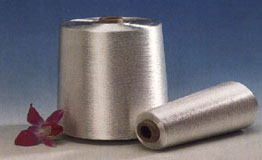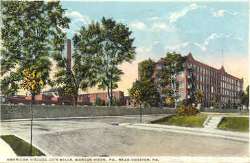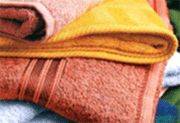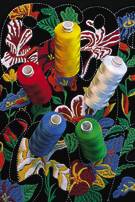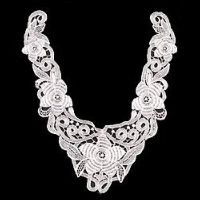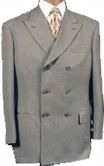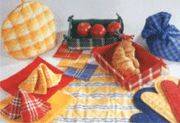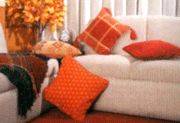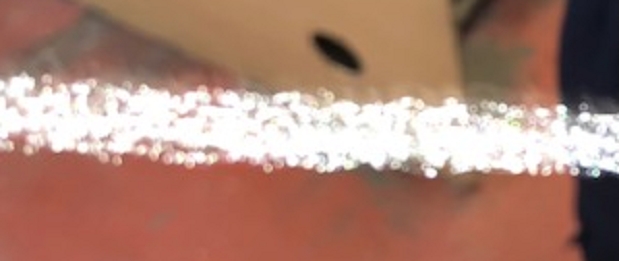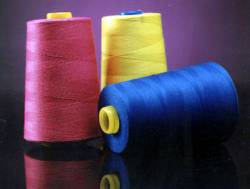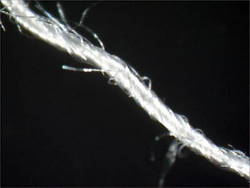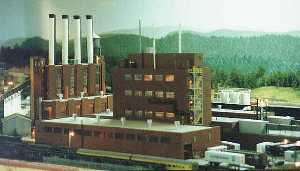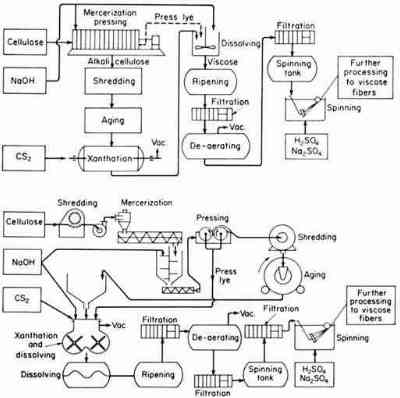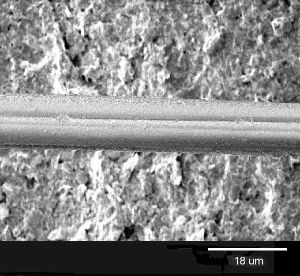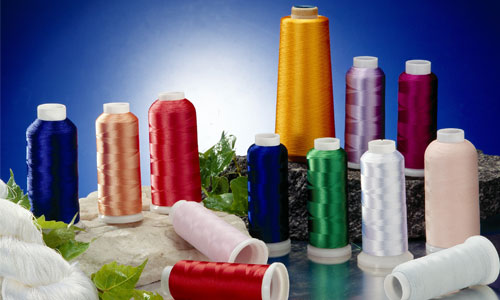
| ||||||||||||||||||||||||||||||||||||||||||||||||||||||||||||||||||||||||||||||||||||||||||||||||||||||||||||||||||
 |
Rayon viscose
Introduction Of all the fibers, rayon is probably the most perplexing to consumers. It can be found in cotton-like end uses, as well as sumptuous velvets and taffetas. It may function successfully in absorbent hygiene and incontinence pads and equally well providing strength in tire cords. What is this fiber that has so many faces? Rayon was the first manufactured fiber. The term rayon was officially adopted by the textile industry. Unlike most man-made fibers, rayon is not synthetic. It is made from wood pulp, a naturally-occurring, cellulose-based raw material. As a result, rayon's properties are more similar to those of natural cellulosic fibers, such as cotton or linen, than those of thermoplastic, petroleum-based synthetic fibers such as nylon or polyester. Although rayon is made from wood pulp, a relatively inexpensive and renewable
resource, processing requires high water and energy use, and has contributed to
air and water pollution. Modernization of manufacturing plants and processes
combined with availability of raw materials has increased rayon's
competitiveness in the market.
HistoryRayon is the generic term for fiber (and the resulting yarn and fabric) manufactured of regenerated cellulose by any one of six processes. Its importance as a fiber lies in its versatility, and in the fact that it was the first viable manufactured fiber. As far back as 1664, English naturalist Robert Hooke theorized that artificial filaments might be spun from a substance similar to that which silkworms secrete to make silk. This was often tried by scientists in the ensuing years who sought an "artificial silk", yet no one was to succeed until in 1855 the Frenchman did so, George Audemars. By dipping a needle into a viscous solution of mulberry bark pulp and gummy rubber, he was able to make a thread. While interesting from a scientific standpoint, this process was hardly viable economically - it was very slow, and required a great deal of skill and precision.
The first commercial synthetic fiber was produced by Hilaire de Bernigaud, Count of Chardonnay (1839-1924) after 29 years of research, was patented in 1884, and manufactured by him in 1889. This cellulose-based fabric known as Chardonnay silk was pretty but very flammable, it was removed from the market. Soon after, the English chemist Charles Frederick Cross and his collaborators Edward John Bevan and Clayton Beadle discovered the viscose process in 1891 (1892?). Courtaulds Fibers produced the first commercial viscose rayon in 1905; the first in the United States was in 1910 by the American Viscose Company. Initially rayon was called "Artificial Silk", and many other names. In 1924 (1926?), a committee formed by the U.S. Department of Commerce and various commercial associations decided upon the name "rayon". It was called "rayon" for one of two reasons: either because of its brightness and similarities in structure with cotton (sun = ray, -on = cotton). Or because the naming committee couldn't find a name from the thousands entered in a contest they sponsored, and who hoped to shed a "ray of light" on the subject (from rayon, French for ray).
Viscose Rayon has a
silk-like aesthetic with superb drape and feel and retains its rich
brilliant colors. Its
cellulosic base contributes many properties similar to those of
cotton or other natural cellulosic fibers. Rayon is moisture absorbent (more so
than cotton), breathable, comfortable to wear, and easily dyed in
vivid colors.
It does not build up static electricity, nor will it pill unless the fabric is
made from short, low-twist yarns.
Rayon is comfortable, soft to the skin, and
has moderate dry strength and abrasion resistance. Like other cellulosic fibers,
it is not resilient, which means that it will wrinkle. Rayon withstands ironing
temperatures slightly less than those of cotton. It may be attacked by
silverfish and termites, but generally resists insect damage. It will mildew,
but that generally is not a problem.
One of rayon's strengths is its versatility and ability to blend easily with
many fibers—sometimes to reduce cost, other times for luster, softness, or
absorbency and resulting comfort.
Rayon has moderate resistance to acids and alkalis and generally the fiber
itself is not damaged by bleaches; however, dyes used in the fabric may
experience color change. As a cellulosic fiber, rayon will burn, but flame
retardant finishes can be applied.
There are four major types or modifications of rayon. Understanding each type
should help clarify differences in product performance.
Other types of rayon have been developed for specialized end uses. These
include disposable, non-woven markets, and high-absorption rayon fibers with
moisture-holding properties for disposable diapers, hygiene and incontinence
pads, as well as medical supplies.
Microfibers
are not a type of rayon, but rather a very fine fiber that
can be manufactured from either regular or HWM rayon. Microfibers are generally
less than one denier in diameter. Rayon microfibers have
been successfully produced at 0.9 denier. Fabrics from microfibers are very
drapable and silk-like in hand and appearance.
By using two different chemicals and manufacturing techniques, two basic
types of rayon were developed - viscose rayon and cupramonium. Other processes
for rayon include the polynosic (modal) process and the now obsolete
nitrocellulose and saponified acetate processes. The nitrocellulose process is
likely obsolete not only because the viscose and cupramonium processes are more
effective, they are also safer; the nitrocellulose process results in a fiber
with explosive properties.
As recently as 1992 there has been an entirely new process developed for
producing regenerated cellulose fibers: the Lyocell process, developed by
Courtaulds. While it is sufficiently different from rayon to almost be in a
class by itself, the U.S. Federal Trade commission has formally amended the
textile rules to add Lyocell as a subclass of rayon.
As viscose is the most common and recognized process for making rayon today,
the process is outlined below. While the United States government considers
fibers from all the above processes rayon, the International Organization for
Standardization (ISO) prefers the name viscose for rayon (regenerated cellulose)
obtained by the viscose process. The name viscose was derived from the word
viscous, which describes the liquid state of the spinning solution.
Dissolution Extrusion Purification
The structure of the rayon fiber is generally that of smooth, inelastic
filaments like glass rods. However, different processes, additives and finishing
techniques can vary the physical appearance and structure of the fiber.
In the burning test, rayon most resembles cotton. It ignites rapidly,
sometimes even faster than cotton, burning with a large, bright, yellow flame.
Burnt rayon leaves an odor like burnt paper, similar to cotton. The ash is also
like cotton: light and feathery gray, which disintegrates rapidly.
In the feeling test, rayon is more difficult to identify. The variety of
processes, modifications of technique and various treatments can make rayon look
and feel like silk, cotton, wool or linen. In general, however, rayon has the
smooth feeling of silk. The breaking test can differentiate between rayon, cotton and linen yarns.
Because of its inelasticity, rayon will tend to break shortly, with a short,
uneven breaking pattern. It is even easier to distinguish when wet, as it breaks
very easily then.
The critical element in successful care of rayon is the type of fiber.
The
low wet strength of untreated viscose rayon is likely to cause shrinkage and
loss of body if fabrics made from these fibers are hand or machine washed.
Viscose rayon are usually labeled "dry clean only." Check and follow
garment labels for care and instructions. Consumers who do not follow care
instructions will have no recourse to manufacturers should damage occur during
laundering.
Since many dyes and finishes applied to viscose rayon are moisture-sensitive,
consumers should protect garments from contact with moisture. Raincoats should
be worn on stormy days. Also, care should be used when washing hands or working
in the kitchen to avoid splashing water. The problem with sizing or dye
migration increases the longer the area remains damp. Spills or moisture should
be blotted with absorbent cloth to remove moisture. Avoid spilling acid or
alkali, such as foodstuffs or perfume, as certain dyes used on rayon are
especially sensitive to these substances. Use caution or avoid treating stained
areas with water. Take the garment to a dry cleaner for stain removal. Rings or
darker shading caused by sizing migration and lighter areas resulting from dye
migration may be permanent.
When viscose rayon can be hand washed, do so with care. Always support wet
fabrics, since rayon has low wet strength and is unstable when wet. Avoid
wringing moisture from fabrics. Gently squeeze out moisture and roll in a towel.
Smooth and shape, then lay flat to dry. If the garments are not too heavy when
wet, they can be hung on a non-rusting hanger.
When pressing regular rayon garments at home, guard against spitting by steam
irons that may cause water spots. Also, if possible, press on the wrong side or
use a press cloth on the right side to avoid shine or iron imprints. Use a rayon
or synthetic setting on the iron. When pressing blends, use the iron temperature
for the most heat-sensitive fiber. Normally, a synthetic setting will be
satisfactory.
High wet modulus or polynosic rayons can usually be machine washed or dried
without special care. Blends, dark colors, and permanent press fabrics should be
washed on a gentle cycle with warm water; however, 100 percent high wet modulus
rayons are normally not damaged by hot water temperatures (more than 140°F).
Tumble dry on a warm setting and remove immediately, or while slightly damp.
Smooth and hang to reduce wrinkling. Polynosic rayons can be line dried;
however, heavy items should be supported by clotheslines to avoid stretching or
loss of shape.
Rayon is probably the most misunderstood of all fibers. It is not a natural
fiber, yet it is not synthetic. It is a fiber formed by regenerating natural
materials into a usable form.
Rayon fibers and fabrics made from them have many desirable properties.
However, consumers sometimes expect performance characteristics beyond those for
which rayon fibers were designed. Although rayon can look like wool, silk,
cotton, or linen and is a manufactured fiber like polyester, this does not mean
it behaves like or has the same properties or care requirements of these fibers.
Rayon is a fiber on its own. Consider each garment made from rayon individually
when determining use and care practices.
And, always read and follow care labels for best performance.
Newstartex
for viscose rayon filament VFY in rawwhite and
spundyed For yarn dyed qualities please
click on below picture | |||||||||||||||||||||||||||||||||||||||||||||||||||||||||||||||||||||||||||||||||||||||||||||||||||||||||||||||||
Background
For centuries humankind has relied upon various plants and animals to provide the raw materials for fabrics and clothing. Silkworms, sheep, beaver, buffalo deer, and even palm leaves are just some of the natural resources that have been used to meet these needs. However, in the last century scientists have turned to chemistry and technology to create and enhance many of the fabrics we now take for granted.
There are two main categories of man-made fibers: those that are made from natural products (cellulosic fibers) and those that are synthesized solely from chemical compounds (noncellulosic polymer fibers). Rayon is a natural-based material that is made from the cellulose of wood pulp or cotton. This natural base gives it many of the characteristics—low cost, diversity, and comfort—that have led to its popularity and success. Today, rayon is considered to be one of the most versatile and economical man-made fibers available. It has been called "the laboratory's first gift to the loom."
In the 1860s the French silk industry was being threatened by a disease affecting the silkworm. Louis Pasteur and Count Hilaire de Chardonnet were studying this problem with the hope of saving this vital industry. During this crisis, Chardonnet became interested in finding a way to produce artificial silk. In 1885 he patented the first successful process to make a useable fiber from cellulose. Even though other scientists have subsequently developed more cost-effective ways of making artificial silk, Chardonnet is still considered to be the father of rayon.
For the next forty years this material was called artificial or imitation silk. By 1925 it had developed into an industry unto itself and was given the name rayon by the Federal Trade Commission (FTC). The term rayon at this time included any man-made fiber made from cellulose. In 1952, however, the FTC divided rayons into two categories: those fibers consisting of pure cellulose (rayon) and those consisting of a cellulose compound (acetate).
By the 1950s, most of the rayon produced was being used in industrial and home furnishing products rather than in apparel, because regular rayon (also called viscose rayon) fibers were too weak compared to other fibers to be used in apparel. Then, in 1955, manufacturers began to produce a new type of rayon—high-wet-modulus (HWM) rayon—which was somewhat stronger and which could be used successfully in sheets, towels, and apparel. The advent of HWM rayon (also called modified rayon) is considered the most important development in rayon production since its invention in the 1880s.
Today rayon is one of the most widely used fabrics in our society. It is made in countries around the world. It can be blended with natural or man-made fabrics, treated with enhancements, and even engineered to perform a variety of functions.
Raw Materials
Regardless of the design or manufacturing process, the basic raw material for making rayon is cellulose. The major sources for natural cellulose are wood pulp—usually from pine, spruce, or hemlock trees—and
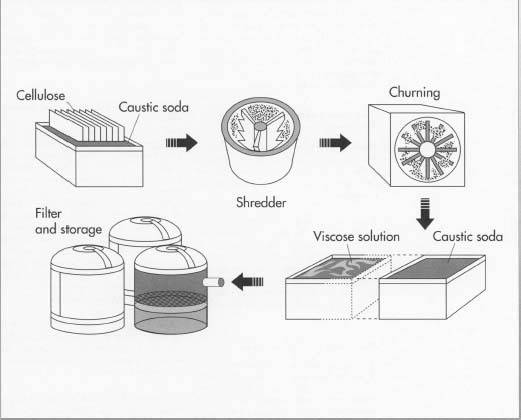
After ageing, the crumbs are combined and churned with liquid carbon disulfide, which turns the mix into orange-colored crumbs known as sodium cellulose xanthate. The cellulose xanthate is bathed in caustic soda, resulting in a viscose solution that looks and feels much like honey.
Strictly defined, rayon is a manufactured fiber composed of regenerated cellulose. The legal definition also includes manufactured fibers in which substitutes have not replaced more than 15 percent of the hydrogens.
While the basic manufacturing process for all rayon is similar, this fabric can be engineered to perform a wide range of functions. Various factors in the manufacturing process can be altered to produce an array of designs. Differences in the raw material, the processing chemicals, fiber diameter, post treatments and blend ratios can be manipulated to produce a fiber that is customized for a specific application.
Regular or viscose rayon is the most prevalent, versatile and successful type of rayon. It can be blended with man-made or natural fibers and made into fabrics of varying weight and texture. It is also highly absorbent, economical and comfortable to wear.
Regular viscose rayon does have some disadvantages. It's not as strong as many of the newer fabrics, nor is it as strong as natural cotton or flax. This inherent weakness is exacerbated when it becomes wet or overexposed to light. Also, regular rayon has a tendency to shrink when washed. Mildew, acid and high temperatures such as ironing can also result in damage. Fortunately, these disadvantages can be countered by chemical treatments and the blending of rayon with other fibers of offsetting characteristics.
High-wet-modulus rayon is a stronger fiber than regular rayon, and in fact is more similar in performance to cotton than to regular rayon. It has better elastic recovery than regular rayon, and fabrics containing it are easier to care for—they can be machine-washed, whereas fabrics containing regular rayon generally have to be dry-cleaned.
The Manufacturing
Process
While there are many variations in the manufacturing process that exploit the versatility of the fiber, the following is a description of the procedure that is used in making regular or viscose rayon.
Regardless of whether wood pulp or cotton linters are used, the basic raw material for making rayon must be processed in order to extract and purify the cellulose. The resulting sheets of white, purified cellulose are then treated to form regenerated cellulose filaments. In turn, these filaments are spun into yarns and eventually made into the desired fabric.
Processing purified cellulose
- 1 Sheets of purified cellulose are steeped in sodium hydroxide (caustic soda), which produces sheets of alkali cellulose. These sheets are dried, shredded into crumbs, and then aged in metal containers for 2 to 3 days. The temperature and humidity in the metal containers are carefully controlled.
- 2 After ageing, the crumbs are combined and churned with liquid carbon disulfide, which turns the mix into orange-colored crumbs known as sodium cellulose xanthate. The cellulose xanthate is bathed in caustic soda, resulting in a viscose solution that looks and feels much like honey. Any dyes or delusterants in the design are then added. The syrupy solution is filtered for impurities and stored in vats to age, this time between 4 and 5 days.
Producing filaments
- 3 The viscose solution is next turned into strings of fibers. This is done by forcing the liquid through a spinneret, which works like a shower-head, into an acid bath. If staple fiber is to be produced, a large spinneret with large holes is used. If filament fiber is being produced, then a spinneret with smaller holes is used. In the acid bath, the acid coagulates and solidifies the filaments, now known as regenerated cellulose filaments.
Spinning
- 4 After being bathed in acid, the filaments are ready to be spun into
yarn. Depending on the type of yarn desired, several spinning methods can be
used, including Pot Spinning, Spool Spinning, and Continuous Spinning. In
Pot Spinning, the filaments are first stretched under controlled tension
onto a series of offsetting rollers called godet wheels. This
stretching reduces the diameter of the filaments and makes them more uniform
in size, and it also gives the filaments more strength. The filaments are
then put into a rapidly spinning cylinder called a Topham Box,
resulting in a cake-like strings that stick to the sides of the Topham Box.
The strings are then washed, bleached, rinsed, dried, and wound on cones or
spools.
Spool Spinning is very similar to Pot Spinning. The filaments are passed through rollers and wound on spools, where they are washed, bleached, rinsed, dried, and wound again on spools or cones.
In Continuous Spinning, the filaments are washed, bleached, dried, twisted, and wound at the same time that they are stretched over godet wheels.
- 5 Once the fibers are sufficiently cured, they are ready for post-treatment chemicals and the various weaving processes necessary to produce the fabric. The resulting fabric can then be given any of a number of finishing treatments. These include calendaring, to control smoothness; fire resistance; pre-shrinking; water resistance; and wrinkle resistance.
High-Wet-Modulus Rayon
Manufacture
The process for manufacturing high-wet-modulus rayon is similar to that used for making regular rayon, with a few exceptions. First, in step #1 above, when the purified cellulose sheets are bathed in a caustic soda solution,
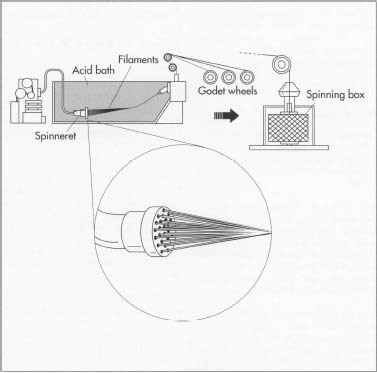
Quality Control
As with most chemically oriented processes, quality control is crucial to the successful manufacture of rayon. Chemical make-up, timing and temperature are essential factors that must be monitored and controlled in order to produce the desired result.
The percentages of the various fibers used in a blended fabric must be controlled to stay within in the legal bounds of the Textile Fiber Identification Act. This act legally defines seventeen groups of man-made fibers. Six of these seventeen groups are made from natural material. They include rayon, acetate, glass fiber, metallics, rubber, and azion. The remaining eleven fabrics are synthesized solely from chemical compounds. They are nylon, polyester, acrylic, modacrylic, olefin, spandex, anidex, saran, vinal, vinyon, and nytril.
Within each generic group there are brand names for fibers which are produced by different manufacturers. Private companies often seek patents on unique features and, as could be expected, attempt to maintain legal control over their competition.
Byproducts
As one of the industry's major problems, the chemical by-products of rayon have received much attention in these environmentally conscious times. The most popular method of production, the viscose method, generates undesirable water and air emissions. Of particular concern is the emission of zinc and hydrogen sulfide.
At present, producers are trying a number of techniques to reduce pollution. Some of the techniques being used are the recovery of zinc by ion-exchange, crystallization, and the use of a more purified cellulose. Also, the use of absorption and chemical scrubbing is proving to be helpful in reducing undesirable emissions of gas.
The Future
The future of rayon is bright. Not only is there a growing demand for rayon worldwide, but there are many new technologies that promise to make rayon even better and cheaper.
For a while in the 1970s there was a trend in the clothing industry toward purely synthetic materials like polyester. However, since purely synthetic material does not "breath" like natural material, these products were not well received by the consumer. Today there is a strong trend toward blended fabrics. Blends offer the best of both worlds.
With the present body of knowledge about the structure and chemical reactivity of cellulose, some scientist believe it may soon be possible to produce the cellulose molecule directly from sunlight, water and carbon dioxide. If this technique proves to be cost effective, such hydroponic factories could represent a giant step forward in the quest to provide the raw materials necessary to meet the world wide demand for man-made fabric.

